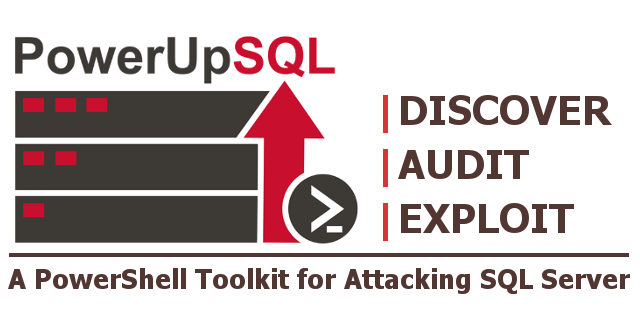-
Notifications
You must be signed in to change notification settings - Fork 464
Home
Scott Sutherland edited this page Jun 20, 2019
·
66 revisions

The PowerUpSQL module includes functions that support SQL Server discovery, auditing for common weak configurations, and privilege escalation on scale. It is intended to be used during internal penetration tests and red team engagements. However, PowerUpSQL also includes many functions that could be used by administrators to quickly inventory the SQL Servers in their ADS domain.
Important Note: PowerUpSQL is used for direct attacks against SQL Server. Currently it does not support SQL Injection. For information on attacking SQL Server through SQL injection check out the NetSPI SQL Injection Wiki.
PowerUpSQL was designed with six objectives in mind:
- Easy Server Discovery: Discovery functions can be used to blindly identify local, domain, and non-domain SQL Server instances on scale.
- Easy Server Auditing: The Invoke-SQLAudit function can be used to audit for common high impact vulnerabilities and weak configurations using the current login's privileges. Also, Invoke-SQLDumpInfo can be used to quickly inventory databases, privileges, and other information.
- Easy Server Exploitation: The Invoke-SQLEscalatePriv function attempts to obtain sysadmin privileges using identified vulnerabilities.
- Scalability: Multi-threading is supported on core functions so they can be executed against many SQL Servers quickly.
- Flexibility: PowerUpSQL functions support the PowerShell pipeline so they can be used together, and with other scripts.
- Portability: Default .net libraries are used and there are no dependencies on SQLPS or the SMO libraries. Functions have also been designed so they can be run independently. As a result, it's easy to use on any Windows system with PowerShell v3 installed.
- Author: Scott Sutherland (@_nullbind), NetSPI - 2018
- Major Contributors: Antti Rantasaari, Eric Gruber (@egru), Thomas Elling (@thomaselling)
- Contributors: Alexander Leary (@0xbadjuju), @leoloobeek, Andrew Luke(@Sw4mpf0x), Mike Manzotti (@mmanzo_), and @ktaranov
- License: BSD 3-Clause
- Required Dependencies: None
- PowerUpSQL Commands
- UNC Path Injection
- Connection Strings
- SQL Server SPN Formats
- SQL Server Detective Controls
- Code Templates
- Introduction to PowerUpSQL
- Blindly Discover SQL Server Instances
- Finding Sensitive Data on Domain SQL Servers
- Finding Weak Passwords for Domain SQL Servers on Scale
- Finding Default Passwords Associated with Application Specific Instances
- Get Sysadmin as Local Admin
- Get Windows Auto Login Passwords via SQL Server
- Establishing Registry Persistence via SQL Server
- Establishing Persistence via SQL Server Triggers
- Establishing Persistence via SQL Server Startup Procedures
- Crawling SQL Server Links
- Attacking SQL Server CLR
- Bypassing SQL Server Logon Trigger Restrictions
- SQL Server as a C2
- Dumping Active Directory Information with SQL Server
- Attacking Stored Procedures via SQLi
- Attacking Insecure Impersonation Configurations
- Attacking Trustworthy Databases
- Enumerating Logins and Domain Accounts via SQL Server
- Using SQL Server to Attack Forest Trusts
- Exploiting Global Temporary Tables
- Hijacking SQL Server Credentials using Agent Jobs for Domain Privilege Escalation
- 2020 May Troopers20 Video
- 2020 May Troopers20 Slides
- 2018 Aug BH Arsenal Video
- 2018 Aug BH Arsenal Slides
- 2017 SEPT DerbyCon7 Video
- 2017 SEPT DerbyCon7 Slides
- 2017 May Secure360 Slides
- 2017 May THOTCON Slides
- 2016 OCT Arcticcon Slides
- 2016 OCT PASS Webinar Video
- 2016 SEPT DerbyCon6 Slides
- 2016 SEPT DerbyCon6 Video
- 2015 APR OWASP Slides
- 2015 APR OWASP Video
- Discover SQL Server Instances
- Unauthenticated to SQL Login - Default Passwords
- Domain User to SQL Sysadmin - UNC Injection
- SQL Login to Sysadmin-Auto
- SQL Login to Sysadmin-LoginEnum+PwGuess
- SQL Login to Sysadmin-Link Crawling 1
- SQL Login to Sysadmin-Link Crawling 2
- SQL Login to OS Admin-UNC Path Injection
- OS Admin to Sysadmin-Impersonation
- Audit Configurations
- Find Sensitive Data
- Attacking SQL Server CLR Assemblies Webinar